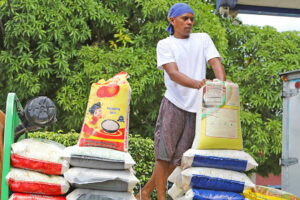THE National Economic and Development Authority (NEDA) has endorsed an executive order (EO) that would extend the temporary reduction of tariff rates on rice, pork, corn, and coal until Dec. 31, 2024, to help further bring down inflation.
“(The EO) will go to the NEDA Board next week. The Committee on Tariff and Related Matters (CTRM) endorsed it… to extend it for one year,” NEDA Secretary Arsenio M. Balisacan said on Wednesday.
If approved, the EO would extend by one year the implementation of lower tariff rates on rice, pork, corn, and coal.
In December 2022, President Ferdinand R. Marcos, Jr. signed EO 10, which had extended the lower tariff rates on key commodities to address rising prices. EO 10 is set to expire on Dec. 31, 2023.
Tariff rates for imports of swine meat were kept at 15% for shipments within the minimum access volume (MAV) quota and 25% for those exceeding the quota. The corresponding rates for corn remained at 5% (within the MAV quota) and 15% (exceeding the MAV quota), and rice at 35% in both cases.
The EO also kept the zero-import duty for coal.
Mr. Balisacan said it is important to sustain the slowdown in inflation and ensure that inflation goes down to within the 2-4% government target range.
“Inflation continues to fall, now down to 4.1% in November 2023, bringing us closer to our target band of 2-4% and nearer to our peers in Southeast Asia,” Mr. Balisacan said in an event hosted by the European Chamber of Commerce of the Philippines.
Headline consumer price index (CPI) fell to 4.1% in November from 4.9% in October and 8% in November 2022. It marked the slowest in 20 months or since the 4% seen in March 2022.
In the eleven months to November, inflation averaged 6.2%, faster than 5.6% in the same period a year ago. This is still above the central bank’s full-year baseline forecast of 6%.
“Still, we remain committed to bringing inflation down further through interagency efforts to address its root causes in the market without relying on the monetary response or cure from our central bank,” Mr. Balisacan said.
Last month, the Bangko Sentral ng Pilipinas (BSP) kept its benchmark interest rate at a 16-year high of 6.5%. The BSP raised borrowing costs by a total of 450 basis points (bps) from May 2022 to October 2023 to tame inflation.
Meanwhile, analysts said headline inflation may further decelerate in December to within the BSP’s 2-4% target.
“After 20 months staying above BSP’s target range of 2-4%, we expect headline inflation in December 2023 to be within the target range,” Maybank Investment Banking Group said in a note.
The bank sees Philippine inflation averaging at 6% this year, before easing to 3.5% in 2024.
“The recent trend in headline and core inflation enhanced our view that BSP will keep interest rate at 6.5% during the last monetary policy meeting for the year, scheduled on Dec. 14,” Maybank said.
BSP Governor Eli M. Remolona, Jr. earlier said the Monetary Board intends to keep rates tighter for longer until the downtrend in inflation has become more evident.
He also said rate cuts are not on the table this year, as inflation may still pick up in the second quarter of next year.
Pantheon Macroeconomics said headline inflation may hit 4% this month, barring any unforeseen supply shocks, as base effects will remain favorable until January.
“We’re sticking to our forecast for a big slowdown in average inflation next year to 2.8% from 6% this year,” it said in a note.
However, Maybank noted there are still upside risks to the inflation outlook such as the El Niño weather event, which may cripple agricultural production and supply, and higher minimum wage adjustments.
Broader geopolitical tensions in the Middle East and further production cuts in global oil output next year may also risk domestic transport inflation to pick up again, it added.
‘MOST EXPOSED’In Asia, the Philippines is the most vulnerable to spikes in food and oil prices, Nomura Global Markets Research said in a report.
“Within Asia, the Philippines is the most exposed, as food and energy account for 43.9% of its CPI basket (rice alone has an 8.9% weighting), and the absence of fuel subsidies implies a direct pass-through to consumers,” Nomura said.
It also said that in every 10% increase in oil prices, there would be a 0.4-percentage-point rise in headline inflation.
“Fiscal policy and supply-side interventions will likely be the first lines of defense. The role of monetary policy is limited in the face of supply-driven pressures but could be activated if second-round effects materialize,” Nomura said.
“This is especially true in the Philippines, where BSP follows its inflation mandate more strictly,” it added. — Keisha B. Ta-asan
